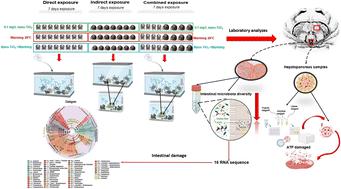当前位置:
X-MOL 学术
›
Environ. Sci.: Nano
›
论文详情
Our official English website, www.x-mol.net, welcomes your
feedback! (Note: you will need to create a separate account there.)
Nano-TiO2 and elevated temperature impair intestinal health in crabs via a mussel-based food chain
Environmental Science: Nano ( IF 5.8 ) Pub Date : 2024-10-08 , DOI: 10.1039/d4en00657g Rim EL Amouri, Zhihan Tu, Mohamed H. Abo-Raya, Xiaotong Wang, Yuntian Shi, Menghong Hu, Youji Wang
Environmental Science: Nano ( IF 5.8 ) Pub Date : 2024-10-08 , DOI: 10.1039/d4en00657g Rim EL Amouri, Zhihan Tu, Mohamed H. Abo-Raya, Xiaotong Wang, Yuntian Shi, Menghong Hu, Youji Wang

|
Nano-titanium dioxide (nano-TiO2) is a ubiquitous contaminant in the marine environment that accumulates in sediments and biological tissues. Coupled with global warming, these challenges can enhance the deleterious properties of nano-TiO2, leading to compounded pollution effects on marine life and ecosystems. This study investigated the effects of nano-TiO2 and increased temperatures on the Japanese swimming crab's gut microbiota and digestive system, Charybdis japonica, through different scenarios. We employed three exposure scenarios: direct exposure (DE) of the crabs to warming and nano-TiO2, indirect exposure (IE) through consumption of mussels Mytilus coruscus subjected to the same conditions, and combined exposure (CE), where crabs were directly exposed to warming and nano-TiO2 while consuming affected mussels. Additionally, a control group was established, comprising Japanese crab C. japonica and thick-shelled mussel M. coruscus that were reared under standard temperature (22 °C, the average annual temperature in the region where the mussels and crabs were sampled) and 0 mg L−1 nano-TiO2 concentration conditions. The findings indicated that warming and nano-TiO2 disrupted the crabs' ATP production, digestive responses, and body chemical composition, leading to intestinal flora dysfunction. Notably, nano-TiO2 exerted a stronger impact on the crabs' digestive enzymes and intestinal flora than warming alone; however, the concurrent presence of warming and nano-TiO2, especially under the direct exposure (DE) conditions, generally exacerbated the negative effects of nano-TiO2. This research provides valuable insights into the implications of nano-TiO2 and elevated temperature on the digestive responses of marine crabs.
中文翻译:

纳米二氧化钛和高温通过基于贻贝的食物链损害螃蟹的肠道健康
纳米二氧化钛(nano-TiO 2 )是海洋环境中普遍存在的污染物,在沉积物和生物组织中积累。再加上全球变暖,这些挑战可能会增强纳米TiO 2的有害特性,导致对海洋生物和生态系统的复合污染影响。本研究通过不同的场景研究了纳米 TiO 2和升高的温度对日本梭子蟹肠道微生物群和消化系统Charybdis japonica的影响。我们采用了三种暴露场景:将螃蟹直接暴露于变暖和纳米TiO 2中,通过食用相同条件下的贻贝进行间接暴露(IE),以及将螃蟹直接暴露在联合暴露(CE)中。在食用受影响的贻贝时暴露于变暖和纳米TiO 2 。此外,还建立了对照组,包括在标准温度(22℃,贻贝和螃蟹采样地区的年平均温度)和0℃下饲养的日本蟹C. japonica和厚壳贻贝M. coruscus。 mg L -1纳米TiO 2浓度条件。研究结果表明,变暖和纳米TiO 2扰乱了螃蟹的ATP产生、消化反应和身体化学成分,导致肠道菌群功能障碍。 值得注意的是,纳米TiO 2对螃蟹的消化酶和肠道菌群的影响比单独变暖更强。然而,变暖和纳米TiO 2的同时存在,特别是在直接暴露(DE)条件下,通常会加剧纳米TiO 2的负面影响。这项研究为了解纳米 TiO 2和高温对海蟹消化反应的影响提供了宝贵的见解。
更新日期:2024-10-08
中文翻译:

纳米二氧化钛和高温通过基于贻贝的食物链损害螃蟹的肠道健康
纳米二氧化钛(nano-TiO 2 )是海洋环境中普遍存在的污染物,在沉积物和生物组织中积累。再加上全球变暖,这些挑战可能会增强纳米TiO 2的有害特性,导致对海洋生物和生态系统的复合污染影响。本研究通过不同的场景研究了纳米 TiO 2和升高的温度对日本梭子蟹肠道微生物群和消化系统Charybdis japonica的影响。我们采用了三种暴露场景:将螃蟹直接暴露于变暖和纳米TiO 2中,通过食用相同条件下的贻贝进行间接暴露(IE),以及将螃蟹直接暴露在联合暴露(CE)中。在食用受影响的贻贝时暴露于变暖和纳米TiO 2 。此外,还建立了对照组,包括在标准温度(22℃,贻贝和螃蟹采样地区的年平均温度)和0℃下饲养的日本蟹C. japonica和厚壳贻贝M. coruscus。 mg L -1纳米TiO 2浓度条件。研究结果表明,变暖和纳米TiO 2扰乱了螃蟹的ATP产生、消化反应和身体化学成分,导致肠道菌群功能障碍。 值得注意的是,纳米TiO 2对螃蟹的消化酶和肠道菌群的影响比单独变暖更强。然而,变暖和纳米TiO 2的同时存在,特别是在直接暴露(DE)条件下,通常会加剧纳米TiO 2的负面影响。这项研究为了解纳米 TiO 2和高温对海蟹消化反应的影响提供了宝贵的见解。


















































 京公网安备 11010802027423号
京公网安备 11010802027423号